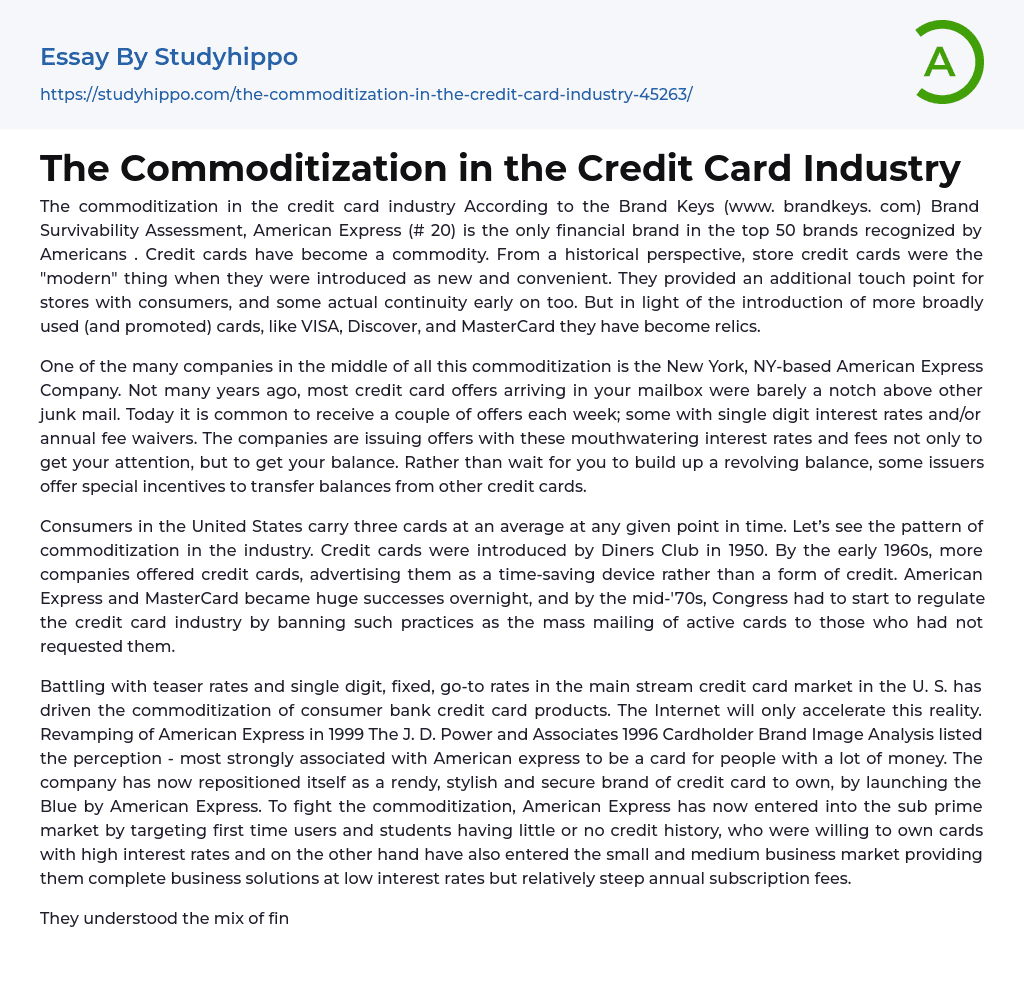

The Commoditization in the Credit Card Industry Essay Example
The widespread availability of credit cards has transformed the credit card industry. According to the Brand Keys Brand Survivability Assessment (www.brandkeys.com), American Express is the sole financial brand recognized among the top 50 brands by Americans. Previously, store credit cards were viewed as modern and convenient choices, but now they are considered commodities. While store credit cards used to connect stores and consumers, the emergence and promotion of widely-used cards like VISA, Discover, and MasterCard have rendered them obsolete relics.
The American Express Company, based in New York, NY, is among the businesses affected by commoditization. In the past, credit card offers received through mail were usually unattractive. However, nowadays it is common to receive multiple offers each week, some of which include low interest rates and waived annual fees. These companies provide these appealing
...terms not only to catch your attention but also to obtain your balance. Instead of waiting for you to accumulate a revolving balance, certain issuers offer incentives for transferring balances from other credit cards.
The average number of cards carried by consumers in the United States is typically three. The industry's commoditization pattern can be seen through Diners Club introducing credit cards in 1950. In the early 1960s, other companies followed suit and promoted credit cards as a time-saving tool rather than just a form of credit. This resulted in American Express and MasterCard experiencing immediate success. Congress had to intervene and regulate the credit card industry, including prohibiting practices such as mass mailing active cards to unsolicited recipients, by the mid-'70s.
Competition between low introductory rates and stable, single-digit fixed rates in the credit card market in the
U.S. is driving a push towards standardization. The internet will further accelerate this process. In 1999, American Express rebranded itself as a trendy and secure credit card option with the introduction of Blue by American Express. Previously associated with wealth, American Express has now entered the subprime market to counteract the trend of commoditization. They are targeting first-time users and students without credit history who are willing to accept high interest rates on their cards. Additionally, they have also expanded into the small and medium-sized business market, offering comprehensive business solutions at low interest rates but with relatively high annual subscription fees.
They comprehended the combination of financial freedom, trend, and security that students required. The company integrated a smart chip onto the new Blue by American Express cards to tackle the safety concern prevalent during the internet boom. This smart card incorporated the secure and versatile nature of Java Card technology. The chip was both groundbreaking and progressive, enabling enhanced and diverse functionalities within one card that could effortlessly adapt to the customer's evolving requirements.
American Express took advantage of the subprime users' lack of financial responsibility and the high interest rates. They distinguished themselves from other credit card companies like Citibank, Capital One, Diners, and Discover by offering personalized spending limits and benefits for each employee in the corporate credit card users market. This approach addressed both the organization's and the individuals' requirements.
Commoditization, as per Christensen, hampers a company's profit-making ability by diminishing distinctiveness. On the other hand, de-commoditization allows for the creation and capturing of significant wealth. American Express, by segmenting the market and personalizing their cards, has positioned itself advantageously
in the value chain compared to Discover and Diners who are grappling to find their place in the value chain.
- Automotive essays
- Real Estate essays
- Construction essays
- E Commerce essays
- Commerce essays
- Polymers essays
- Automotive Industry essays
- Paper Industry essays
- Textile Industry essays
- Pharmaceutical industry essays
- Pharmacy essays
- Grocery stores essays
- Classical Mechanics essays
- Rail Transport essays
- Tata Motors essays
- Vehicle Brands essays
- trucks essays
- Auto Racing essays
- Harley-Davidson essays
- Suzuki essays
- Lexus essays
- Mercedes-Benz essays
- Buying Homes essays
- Futures Contract essays
- Mortgage Loan essays
- Renting essays
- Transaction Cost essays
- Building essays
- Optical Fiber essays
- Freezing essays
- Polymer essays
- Weaving essays
- Bank essays
- Banking essays
- Corporate Finance essays
- Credit Card essays
- Currency essays
- Debt essays
- Donation essays
- Enron Scandal essays
- Equity essays
- Financial Accounting essays
- Financial Crisis essays
- Financial News essays
- Financial Ratios essays
- Financial Services essays
- Forecasting essays
- Foreign Exchange Market essays
- Free Market essays
- Gold essays



